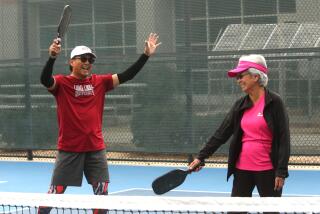A Leisure World of Data : Medical Study of Community Offers Wealth of Information
- Share via
When Leisure World resident Nelda Sledge reached into her mailbox one day in 1981 and found a detailed 12-page questionnaire mixed in with the bills, grocery ads and magazine sweepstakes promotions, she didn’t know she was holding a ticket into the medical history books.
But as soon as she saw the letters USC on the cover, she knew she had no choice but to sit down and fill it out.
When were you born?
How tall are you? How much do you weigh?
How many children have you had?
“I received my master’s degree from USC, so naturally I had to help,” says Sledge, now 79, a resident of the community since 1979.
All 22,781 residents of the Laguna Hills retirement community received the same questionnaire that day and in two follow-up mailings. Thousands threw it away, possibly mistaking it for just another piece of junk mail or simply deciding it wasn’t worth the trouble or they weren’t interested in becoming human guinea pigs. But 13,987 of them, 61% of the community--took the time to answer and return it.
Have you ever had your gallbladder surgically removed?
Have you ever had cataract surgery?
Have you EVER smoked cigarettes during any period of your life (aside from possibly trying them once or twice?)
What most of the respondents didn’t know then, and may not even now, is that the project they were being asked to participate in wasn’t just another survey.
What has since become known in the medical literature as “The Leisure World Cohort Study” would give researchers now and in years to come a veritable Comstock Lode of data on the health of women and men over 55, a rich vein of information that could be mined over and over for different purposes.
It has been written about again and again in medical journals and will soon be featured as part of the Lifetime cable channel’s medical programming.
The information gathered has enabled researchers to define in meticulous, unprecedented detail not only the process of aging, but how that process is affected by a broad spectrum of external factors, from estrogen supplements to afternoon naps.
The study has been under way for a decade now, and it will continue as long as its subjects are alive, “or as long as we have funding,” says Dr. Annlia Paganini-Hill of Laguna Beach, a professor of preventive medicine at the USC School of Medicine and one of the primary researchers.
Current funding was from the National Cancer Institute extends through March, 1992, and is expected to be continued. The study cost $175,000 to run this year.
Most medical studies, Paganini-Hill explains, are what are called case control studies. “You identify a subject who has a disease and compare them with a subject who is undiseased, for example.” In that type of study, researchers look for one specific factor at a time, such as the link between breast cancer and estrogen.
But case controlled studies may not be the most accurate, Paganini-Hill says, because “people who’ve been diagnosed with a disease are likely to remember more about possible causative factors than those who haven’t, just because they’ve gone through that process of racking their brains to try to think of something that may have contributed to it. The other people may have had the same exposure, but they may not remember it.”
Another method, used less often because of the work and expense involved, is what’s called a cohort study, in which a large group of subjects, such as the residents of Leisure World, are surveyed for a long list of factors, Paganini-Hill explains.
Researchers interested in any item on that list--kidney disease, for example--can then go back through the information and try to find connections to possible causes.
Leisure World was a perfect setting for such a study, Paganini-Hill says, because of its unusual demographics. The community, founded in 1964, was one of the first of its kind in the nation, requiring at least one member of each household to be at least 55.
That gave researchers a self-contained community with a median age of 73, two-thirds female. Aside from their ages, Leisure World residents tended to be alike in other ways as well. Researchers found they were almost all white, moderately affluent and well-educated. They also tend to be active and fitness-conscious, the USC project found. All those factors made Leisure World an ideal living laboratory for a preventive medicine study.
So far, the study has found that, among other things:
* Estrogen replacement therapy for post-menopausal women can decrease mortality by 40%, despite the increased risk of certain kinds of cancer.
* Aspirin taken regularly can help prevent heart attacks in men who already have cardiovascular disease but isn’t recommended for men or women who don’t because it increased the risk of stroke by 20% and also was associated with an increase in kidney disease.
* Increased weight is associated with decreased levels of HDL (good) cholesterol, which means a greater risk of heart disease, while increased exercise can raise those levels and reduce the risk of heart disease.
So far, there are no reports on the health effects of such activities as gardening, television-watching or going to concerts, or eating such foods as lima beans, persimmons or guacamole--some of the hundreds of specific questions on the original survey. But the information is there for any researcher who wants to look for possible connections.
That’s actually how the information on aspirin came out, Paganini-Hill says. After another group of researchers published their findings linking aspirin with a reduction in heart attacks, the USC team was able to go back through the information it had gathered and come up with information not only on heart attacks but on other factors as well.
USC researchers began studying Leisure World residents 20 years ago, when they conducted a survey to determine the frequency of diseases such as heart disease and cancer. At the time, Leisure World even had its own medical records for residents, which made the process even easier. Now the research group studies records from five local hospitals, with 85% of the information coming from nearby Saddleback Memorial Medical Center.
The project staff keeps track of each time a subject is hospitalized, but not individual visits to the doctor. That’s about 40,000 hospitalizations each year, according to Paganini-Hill.
Researchers also regularly check their list of subjects’ names against a list of deaths in Orange County and elsewhere, which enables them to track down death certificates and record the cause of death. As of January, the team has lost track of only 22 of the subjects. About a third of the original survey population has died, Paganini-Hill says.
Some residents have been singled out for further tests for specific parts of the study.
One of those, Al Hally, 85, says he was glad to do it. “I got involved mostly because I thought it was a worthwhile thing and I might be able to profit from some of the findings,” he says. “I was getting along in years, and I hoped that along the way they’d find out something that would be good for me and also for other people as they get older.
“I’m physically in pretty good shape. All through my life I’ve kept up a continuous exercise program. I played handball and squash when I was younger, and I still do an hour of calisthenics every day. I figured that if they could get one good apple in the picture, it might help.”
Sledge has been able to see herself in the statistics produced by the study, because she was one of the women taking estrogen. “I took it for umpteen years. It was great. But then I developed a blood clot about a year ago and had to stop.”
Sledge, a retired teacher, walks two to three miles a day with her dog. “I haven’t seen a doctor yet this year,” she says.
Helen Loring, also 79, a retired marriage, family and child counselor who is still active in volunteer work, agreed to participate in the study because of her own interest in health. Since she moved to Leisure World in 1974, she has organized numerous health workshops and presentations, featuring such notables as the late Nathan Pritikin. She shows up in the study’s findings on exercise. “I believe that the body talks to us, and we need to learn how to listen,” she says. “I’m about a 90% vegetarian, and I exercise in the gym here. Sometimes I get distracted from my program, but my body tells me when I don’t and I have to get back to it.”
As the study subjects get older, Paganini-Hill says, she looks forward to learning more about advanced aging by studying specific factors related to people who live into their 90s or beyond. “Not much is known about them,” she says. “They’ve always been lumped together with much younger people. We want to see what we can differentiate about them.”
More to Read
Sign up for Essential California
The most important California stories and recommendations in your inbox every morning.
You may occasionally receive promotional content from the Los Angeles Times.













